
Home / Parts of an internal door latch
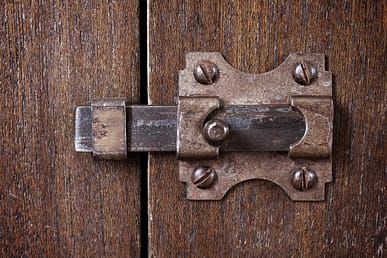 An internal door latch is a critical component to the security and privacy of any door! It’s the only way to allow someone to close a door and be assured that it will stay closed. Understanding the parts of an internal door latch can be extremely helpful for anybody who needs to install or repair their door handles, and that’s why we’re going to look into this today!
An internal door latch is a critical component to the security and privacy of any door! It’s the only way to allow someone to close a door and be assured that it will stay closed. Understanding the parts of an internal door latch can be extremely helpful for anybody who needs to install or repair their door handles, and that’s why we’re going to look into this today!
In this article, we’ll discuss what exactly an internal door latch is before exploring the different parts and how they work. We’ll also discuss the differences between interior and exterior door latches.
The door latch mechanism itself sits within the door, between the handles. It’s composed of several parts including the spindle hole, strike plate, and latch bolt – all of which we’ll go into in more detail. The latch is responsible for securing a door in place – it’s operated by a turn and release mechanism that’s activated by rotating the door handles.
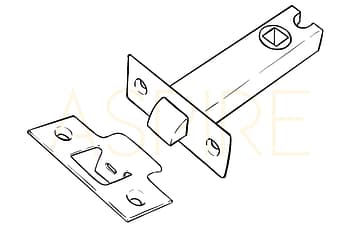
An internal door lock has less responsibility than an external door latch, as it only needs to secure a door in place temporarily, rather than keep intruders out using a lock. You’ll occasionally find an internal door latch that locks as well – these are commonly used on bathroom doors, and occasionally bedroom doors.
An internal door latch is made up of relatively simple parts. These parts all work together with the door handles to secure the door in place. The most common latch used for internal doors are tubular latches.
The components of the tubular latch include the following:
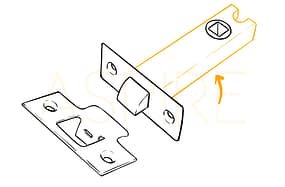 The Case: The case is part of the latch that houses the latch bolt. It also includes the spindle hole, which is rotated when a door handle is turned, pulling the latch into the case. It additionally provides a mounting point for door handles and levers.
The Case: The case is part of the latch that houses the latch bolt. It also includes the spindle hole, which is rotated when a door handle is turned, pulling the latch into the case. It additionally provides a mounting point for door handles and levers.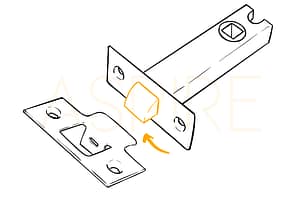
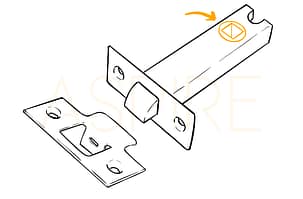
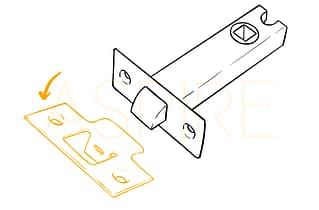
Now that we understand the different parts of an internal door latch, we can look at how they all fit together to make a door latch properly!
The door handle components work in line with the door latch assembly to create a fully functioning door handle. The door handle’s spindle will fit into the spindle hole, which is typically square-shaped. When a door handle is rotated, it rotates the spindle along with it. This rotation causes the mechanism in the spindle hole to rotate, pulling back the spring-loaded bolt, and allowing the door to open.
Oftentimes, a door locking mechanism will be separate from the door handle latch, though door locks often use latches as well. The most common example of this is the internal locks on a bathroom door, and occasionally a bedroom door. The door lock on a bathroom door is often in the form of a tubular latch (or a mortice latch, also sometimes called a mortice lock) which is operated using a thumb turn. These tubular latches are pushed past the strike plate (the metal plate on the door frame) and into a hole in the door frame. This will keep the door closed until it is unlocked from the inside.
The door frame is what keeps the door in place when inactive. The bolt, naturally sitting past the latch casing, will fit into a recess in the door frame, which is covered by a strike plate. This recess will keep the bolt in place unless activated, by turning the handles of the door.
Internal and external latches may look similar at first, but there are several differences between the two that are important to differentiate.
The first, and potentially most obvious difference is their intended use. Internal door latches are designed to be used inside buildings – to secure bedrooms, bathrooms, and other internal rooms. On the other hand, external door latches are designed to be used on exterior doors, and so must be able to withstand the seasonal weather changes and keep intruders out when needed. Because of this, external door latches are usually more durable than internal latches. The level of security will also differ between the two latches. External latches may be longer and more heavy-duty than internal latches and may have additional security features attached to the door handle mechanism.
Because of the additional security features, you may also find a difference in the design of internal and external latches. Internal latches can be quite simple, while external latches may feature more complex mechanisms that make them more difficult to break.
You may also find that, because of the exposure to the elements, external latches are more prone to wear and tear, and so may need extra maintenance.
Take a look at our additional articles on latches, locks, and handles to learn everything you can about these important pieces of door hardware.
You’ll need to trim mm off the left & right of each door
You’ll need to pack mm either side of the frame
You’ll need to trim mm off the top and bottom of each door
You’ll need to pack mm above
You’ll need to trim mm off the left & right of each door
You’ll need to pack mm either side of the frame
You’ll need to trim mm off the top and bottom of each door
You’ll need to pack mm above
You’ll need to trim mm off the left & right of each door
You’ll need to pack mm either side of the frame
You’ll need to trim mm off the top and bottom of each door
You’ll need to pack mm above